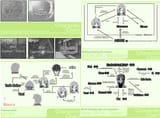Search Results
6/16/2025, 6:23:15 AM
>>49575040
Booting it up again to grab screenshots I'm realizing I probably don't get most of it.
It feels unfinished in some places, surreal and strange, but it's got a lot of heart so I recommend trying it if you like WTC.
I'm talking very broadly here. It's actually interesting as it's written. But basically the protagonist lives in a static world, a modern world you'd find in the 90s, and an almost utopia. He finds a magic door and crosses a barrier into a very rural very friendly Higurashi-like world. And since it's a world inspired by Higurashi it's very friendly but everything goes wrong after a certain date. After experiencing loops he discovers the Higurashi-like world is being used by witch like being who enacts the tragedy for a certain reason.
In the next act is discovering there's a whole system of these worlds all interconnected in a dreamlike way, like how he found a door into Higurashi land. This part is very reminiscent of how Umineko seems to work. Many different gameboards, and they have different stories and the Asgard world has people with Norse myth names who administer to these, killing the worlds, looping them, or letting them be at their leisure.
In the final act it resembles Ciconia not in story, but in the shape of what I believe Ciconia's meta world is. After moving through different worlds modern, scifi, and back to the Higurashi-like world they discover the truth that the whole meta world system is an AI program. The world ended long ago, they're just former humans recorded into the computer. Odin is the admin program, and her gods (or witches) are humans that are given tasks to make the world an interesting place to live. Enact strange stories and such, forever, eternally in their prison of the computer program that houses their minds, all that is left of humanity after the nukes fell. Odin doesn't want to live out this farce forever so she attempts to shut everything down and end the world. She thinks that in destroying the virtual world the real creator will come back and fix things. Odin just wants to meet her "God".
So basically I think the entire WTC world is a virtual program, the witches are humans with admin rights, perhaps one of the witches in particular is the true admin like Featherine. The factory scene is the lingering memory of their "processing". They're brains and spines in jars. The goal is to make interesting stories at the end of the world since there is nothing really else to do with the last remnants of humanity that has perished.
Booting it up again to grab screenshots I'm realizing I probably don't get most of it.
It feels unfinished in some places, surreal and strange, but it's got a lot of heart so I recommend trying it if you like WTC.
I'm talking very broadly here. It's actually interesting as it's written. But basically the protagonist lives in a static world, a modern world you'd find in the 90s, and an almost utopia. He finds a magic door and crosses a barrier into a very rural very friendly Higurashi-like world. And since it's a world inspired by Higurashi it's very friendly but everything goes wrong after a certain date. After experiencing loops he discovers the Higurashi-like world is being used by witch like being who enacts the tragedy for a certain reason.
In the next act is discovering there's a whole system of these worlds all interconnected in a dreamlike way, like how he found a door into Higurashi land. This part is very reminiscent of how Umineko seems to work. Many different gameboards, and they have different stories and the Asgard world has people with Norse myth names who administer to these, killing the worlds, looping them, or letting them be at their leisure.
In the final act it resembles Ciconia not in story, but in the shape of what I believe Ciconia's meta world is. After moving through different worlds modern, scifi, and back to the Higurashi-like world they discover the truth that the whole meta world system is an AI program. The world ended long ago, they're just former humans recorded into the computer. Odin is the admin program, and her gods (or witches) are humans that are given tasks to make the world an interesting place to live. Enact strange stories and such, forever, eternally in their prison of the computer program that houses their minds, all that is left of humanity after the nukes fell. Odin doesn't want to live out this farce forever so she attempts to shut everything down and end the world. She thinks that in destroying the virtual world the real creator will come back and fix things. Odin just wants to meet her "God".
So basically I think the entire WTC world is a virtual program, the witches are humans with admin rights, perhaps one of the witches in particular is the true admin like Featherine. The factory scene is the lingering memory of their "processing". They're brains and spines in jars. The goal is to make interesting stories at the end of the world since there is nothing really else to do with the last remnants of humanity that has perished.
Page 1
